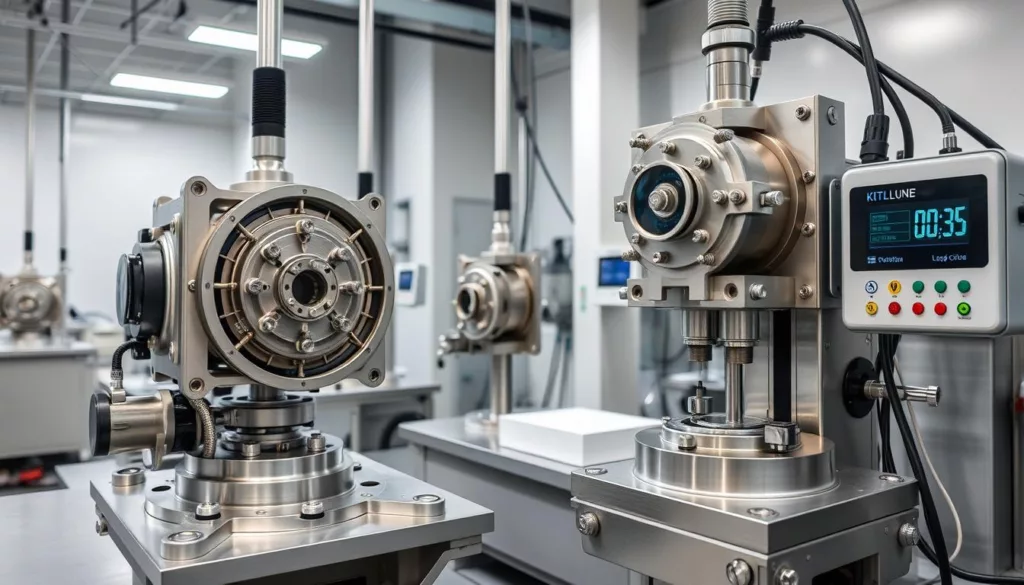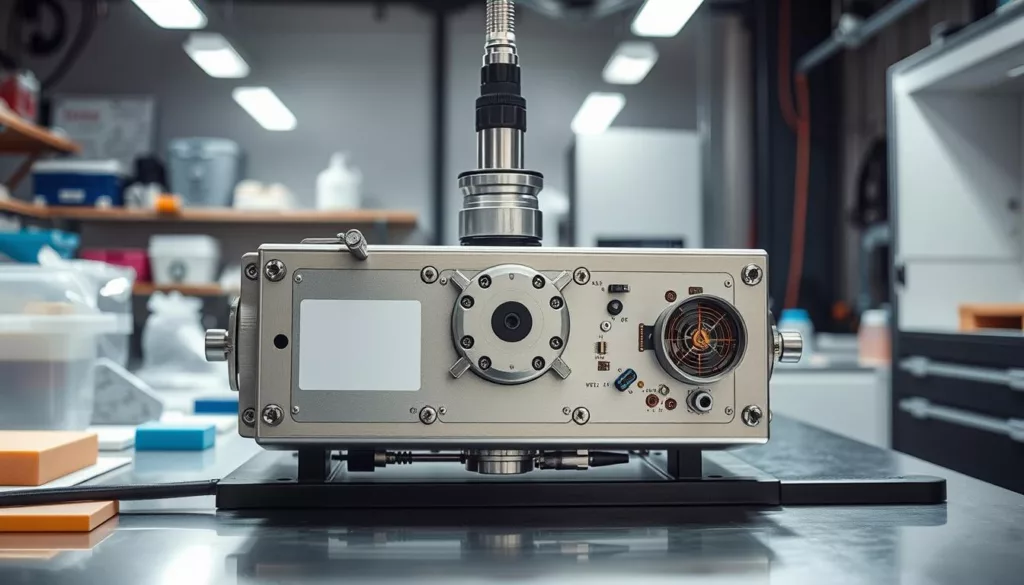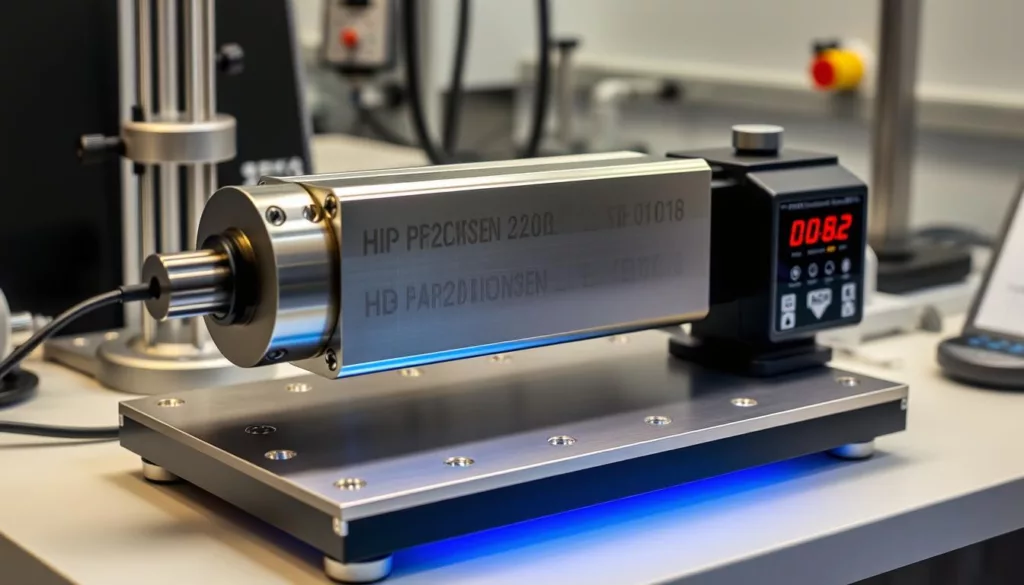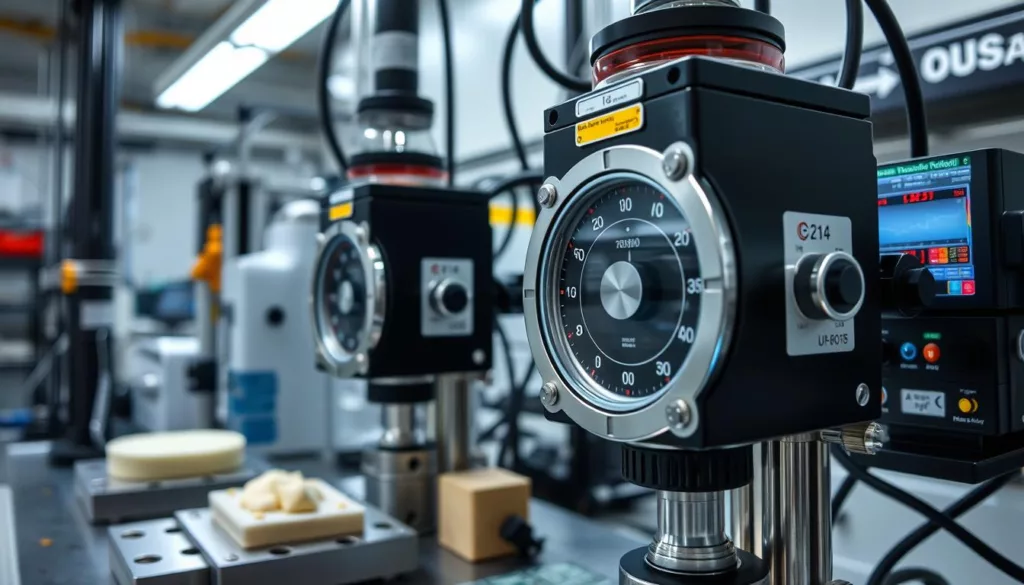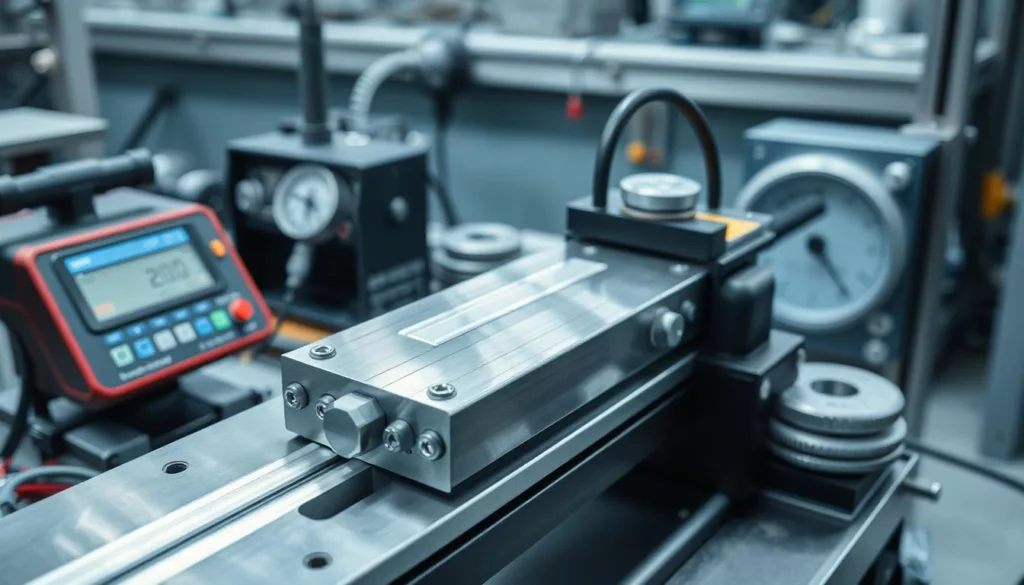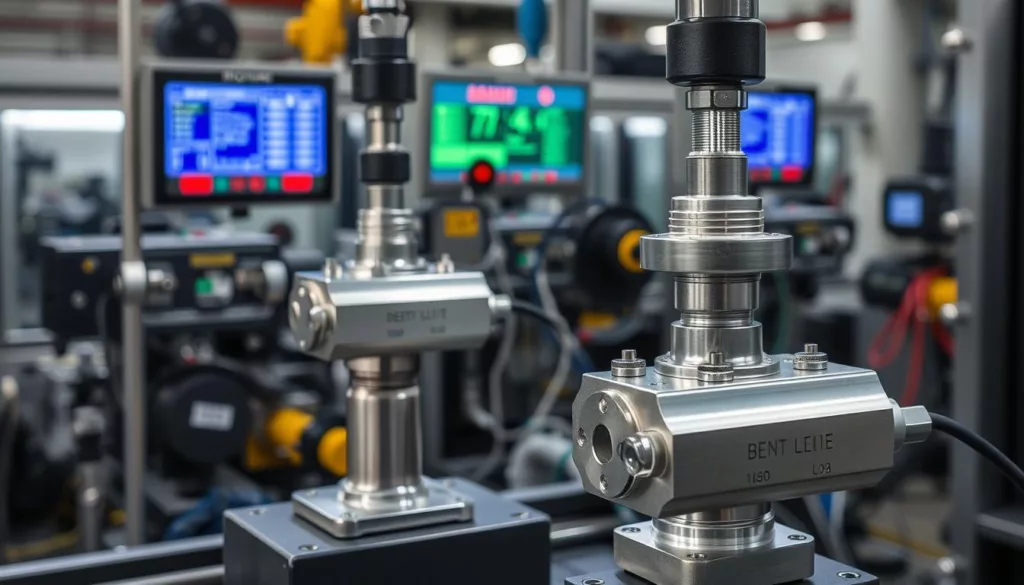In the world of material testing and product quality, high-precision load cells are key. They ensure accurate force measurements. These advanced sensors are vital for engineers, researchers, and manufacturers in many fields.
High-precision load cells offer top accuracy and sensitivity. They are vital for precise material testing. This includes checking the strength and durability of materials used in construction, aerospace, and electronics.
Thanks to new sensor tech and software, these load cells give real-time, detailed measurements. This helps engineers and researchers make better decisions. It also helps in optimizing product designs and meeting industry standards.
Key Takeaways
- High-precision load cells are key for accurate force and weight measurement in material testing.
- These advanced sensors offer top accuracy, sensitivity, and repeatability for evaluating material performance.
- New sensor tech, data processing, and software integration enable real-time, high-resolution measurements for informed decision-making.
- High-precision load cells are essential for ensuring product quality, safety, and compliance with industry standards.
- Continuous innovation in load cell technology is driving advancements in material testing and quality assurance across various industries.
Understanding High-Precision Load Cells
High-precision load cells are at the core of material testing. They are advanced sensors that measure forces accurately. These strain gauge load cells, hydraulic, and pneumatic load cells are key in testing materials’ strength and durability. They are used in construction, aerospace, and electronics.
Definition and Functionality
Load cells change mechanical force into an electrical signal. This signal is then processed to give exact load measurements. Their high precision helps in reliable material testing.
Key Components
The main parts of a high-precision load cell are:
- Strain gauges: These sensors measure deformation and send an electrical signal
- Load-bearing structure: It transfers the force to the strain gauges
- Amplifier and signal conditioning circuits: They process and scale the electrical output
Types of Load Cells
While strain gauge load cells are common, other types are used too:
- Hydraulic load cells: Use fluid pressure for force measurement, good for tough environments
- Pneumatic load cells: Use air pressure, perfect for dangerous areas
- Piezoelectric load cells: Use crystals for fast dynamic response
| Load Cell Type | Key Characteristics | Typical Applications |
|---|---|---|
| Strain Gauge | High accuracy, repeatability, and flexibility | Material strength testing equipment, general force measurement |
| Hydraulic | Rugged construction, suitable for harsh environments | Heavy machinery, industrial scale weighing |
| Pneumatic | Explosion-proof, suitable for hazardous areas | Chemical processing, mining operations |
| Piezoelectric | Extremely fast dynamic response, high resolution | Vibration and impact measurement, high-speed testing |
“High-precision load cells are the backbone of material testing, ensuring the accuracy and reliability of data that drives engineering advancements.”
Applications in Material Testing
High-precision micro load cells are key in checking many materials. They are vital for quality control and product development in many fields. These sensors give accurate data for important tests and analysis.
Construction Materials
In construction, micro load cells check the strength and durability of materials like concrete and steel. These material strength testing equipment help engineers see how well building materials hold up under different loads. This ensures buildings are safe and strong.
Aerospace and Automotive Industries
The aerospace and automotive fields use environmental stress screening and non-destructive testing instruments a lot. Micro load cells are key in these tests. They measure forces and stresses on parts, improving product quality and safety.
Electronics and Micro-manufacturing
In electronics and micro-manufacturing, micro load cells are essential. They help engineers test and develop small parts and devices. These sensors measure forces in assembly and operation, making sure products work well.
“Micro load cells have become indispensable tools in material testing across a wide range of industries, empowering engineers and researchers to gather accurate, real-time data that informs critical design decisions and quality assurance processes.”
Advantages of High-Precision Load Cells
Using high-precision load cells in material testing brings many benefits. These advanced sensors are key for checking the quality and safety of materials. They are used in construction, aerospace, and electronics.
Enhanced Accuracy and Reliability
Load cells are made to measure forces accurately and reliably. They are designed to reduce errors and give consistent results. This is vital for making good decisions and keeping quality high in manufacturing and research.
Real-time Measurement Capabilities
High-precision load cells can give data in real-time. This lets researchers and engineers see how materials behave and make quick changes. It makes the testing process more efficient and productive.
Improved Data Analysis
These sensors work with advanced systems to give detailed data. This data helps in deeper analysis and making better decisions. It improves the reliability and performance of materials and products.
“The use of high-precision load cells has been a game-changer in our material testing lab, allowing us to obtain reliable data that informs our product design and quality control processes.”
– *Lead Engineer, Aerospace Manufacturer*
Selecting the Right Load Cell
Choosing the right load cell is key for accurate material testing. Strain gauge load cells, compressive and tensile force sensors, and calibration are vital. We’ll look at what to consider, technical specs, and environmental factors for the best load cell.
Considerations for Material Testing
First, understand your material testing needs. Think about these factors:
- Load capacity: Make sure the load cell can handle the expected forces.
- Accuracy and resolution: Decide how precise you need your measurements.
- Mounting requirements: Check the load cell’s size, mounting options, and installation needs.
Load Cell Specifications
Look at the load cell’s technical specs to meet your testing needs. Key points include:
- Strain gauge technology: Strain gauge load cells are precise and often used in testing.
- Capacity and sensitivity: Choose a load cell that fits your force range and detail needs.
- Linearity and hysteresis: Find load cells with low errors for accurate measurements.
Environmental Factors
The testing environment affects load cell choice. Consider these factors:
| Factor | Considerations |
|---|---|
| Temperature | Make sure the load cell works in your expected temperature range. |
| Humidity | Choose a load cell for your humidity conditions. |
| Vibration and shock | Find a load cell that can handle your setup’s vibration and shock. |
By thinking about these factors, you can pick the right load cells. This ensures accurate and reliable material testing results.
Calibration and Maintenance
Keeping high-precision load cells accurate and reliable is key for material testing. Regular calibration and careful maintenance are vital. They help these sensors work at their best for a long time.
Importance of Calibration
Calibration is the foundation for precise load cell calibration, precision weighing systems, and material strength testing equipment. It ensures the load cell’s measurements stay true. This is essential for making accurate decisions.
Calibration Methods
- Static Calibration: This method uses known weights to check the load cell’s accuracy.
- Deadweight Calibration: It uses precision deadweights for a precise check of the load cell’s performance.
- Automated Calibration: This method uses computers to make calibration faster and more efficient.
Regular Maintenance Practices
Regular upkeep is essential for precision weighing systems and material strength testing equipment. Here are some tips:
- Regularly clean and inspect load cells to remove dirt or contaminants.
- Check cable connections and ensure they are grounded to avoid electrical issues.
- Follow a maintenance schedule to catch problems early and prevent performance drops.
By focusing on calibration and maintenance, companies can keep their load cells working well. This ensures reliable data for important material testing tasks.
Innovations in Load Cell Technology
In the fast-changing world of material testing, high-precision load cells lead the way. These advanced sensors work with the Internet of Things (IoT). They give real-time data that makes testing more efficient and accurate.
Integration with IoT
Load cells now connect with IoT, starting a new era in smart testing. They use cloud computing and wireless tech to send data fast. This lets engineers check material performance live, from anywhere.
This connection helps make quicker decisions, smoother workflows, and better teamwork worldwide.
Advanced Sensor Technology
Load cell makers keep improving sensor tech. They’ve made ultra-sensitive piezoelectric and strain gauge designs. These offer top accuracy and reliability.
These sensors can spot tiny force changes. They give deep insights into materials, from construction to aerospace and electronics.
Software Enhancements
The software for these load cells has also gotten better. It now has easy-to-use interfaces, advanced data analysis, and predictive maintenance. This makes testing easier and more valuable.
These updates make material testing more efficient and user-friendly. They help professionals innovate and ensure product quality and safety.
Industry Standards for Load Cells
In the world of material testing, load cells must meet strict standards. These standards ensure they are reliable, accurate, and consistent. They guide the design and manufacturing of load cells. They also outline the testing and calibration procedures for material strength testing equipment, environmental stress screening, and load cell calibration.
ISO Standards
The International Organization for Standardization (ISO) has set detailed standards for load cells. ISO 376, for example, specifies how to calibrate force-measuring devices. These standards make sure load cells used in material testing meet key performance criteria. This includes accuracy, repeatability, and linearity.
ASTM Guidelines
The American Society for Testing and Materials (ASTM) also sets important guidelines for load cells. ASTM E4, for instance, outlines how to verify the force-measuring capabilities of testing machines. These machines are used in many industries, from construction to aerospace.
Compliance Requirements
- Following ISO and ASTM standards is often a must for companies in regulated industries. This includes aerospace, automotive, and medical device manufacturing.
- Load cell makers must make sure their products meet these standards. This is to be accepted and used in these critical areas.
- It’s key to regularly calibrate and maintain load cells. This keeps them in compliance and ensures reliable material testing data over time.
Material testing experts can be sure their load cell calibration practices and equipment are top-notch. This is by keeping up with the latest industry standards and guidelines. It supports the creation of better products and materials.
Case Studies: Success with Load Cells
At XJCSENSOR, we’re proud of our high-precision load cells. They’re top-notch for material testing in many industries. We share success stories to show how our sensors help our clients.
Construction Project Examples
In a big construction project, our sensors were key. They tracked forces in a high-rise building’s construction. This gave the team real-time data to ensure safety and stability.
The project finished on time and under budget. Our load cells were reliable and precise.
Aerospace Testing Applications
The aerospace world needs top-notch testing tools. Our load cells have been a game-changer. They measured forces on aircraft parts in lab tests.
This data helped create safer, better aircraft. It’s a big win for the industry.
Laboratory Research Findings
In material science, our sensors have led to big discoveries. Scientists used them to study new materials. This led to lighter, stronger structures.
Our sensors gave them the accurate data they needed. This drove their research forward.
These stories show how our load cells make a difference. They help our clients succeed in their fields. Our technology is a game-changer.
Load Cell Manufacturers in the U.S.
The United States is a top spot for finding force measurement sensors and precision weighing systems. These are key for testing material strength. Here, we’ll look at the best load cell brands in the country. We’ll compare their products and talk about their customer support.
Leading Brands
Top load cell makers in the U.S. include Honeywell, OMEGA Engineering, Flintec, Vishay Precision Group, and Interface Force Measurements. They lead the industry with a variety of load cells and accessories. Their products serve many sectors like construction, aerospace, and electronics.
Comparative Analysis
| Brand | Product Range | Accuracy | Capacity |
|---|---|---|---|
| Honeywell | Miniature, Compression, Tension, Shear Beam, and S-Type Load Cells | ±0.03% to ±0.25% Accuracy | 50 lbs to 100,000 lbs |
| OMEGA Engineering | Strain Gage, Hydraulic, Pneumatic, and Piezoelectric Load Cells | ±0.1% to ±1% Accuracy | 0.25 lbs to 1,000,000 lbs |
| Flintec | Compression, Tension, Shear Beam, and Bending Beam Load Cells | ±0.02% to ±0.05% Accuracy | 10 lbs to 500,000 lbs |
Customer Support Services
These leading U.S. load cell makers offer great customer support. They help with technical issues, application engineering, and more. Their support ensures their products work well and last long.
“Our partnerships with leading load cell manufacturers have been instrumental in delivering high-quality, customized solutions to our clients across various industries.”
Future Trends in Load Cell Development
The future of load cell technology looks bright, with exciting changes on the horizon. Sustainability and eco-friendly designs are becoming more important. Manufacturers are working on load cells that use recycled materials and save energy.
Sustainability and Eco-Friendly Designs
Companies like Futek and Omega Engineering are leading the way. They’re making load cells that are good for the planet. These instruments use less energy, have lower carbon footprints, and are made from recyclable parts.
Growth of Smart Load Cells
The Internet of Things (IoT) and better sensors are making smart load cells possible. These devices work well with data systems, allowing for real-time monitoring and remote access. Brands like Transducer Techniques and Loadstar Sensors are making these smart load cells, helping professionals make better decisions.
Emerging Markets and Applications
Load cell technology is set to enter new markets, like environmental stress screening and renewable energy. Manufacturers are adapting their products to meet these needs. This ensures load cells remain vital in material testing and measurement.


